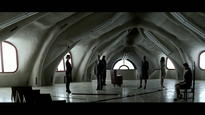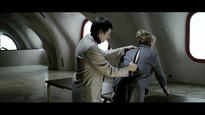MARKUS SCHINWALD
EXHIBITION
The work of Austrian artist Markus Schwinwald (1973) is centred around the body as a cultural construct, as an incessantly actualized site at which the subject is constituted both in its identity and its instability and transversality. He is not true to one medium, but rather nomadic as he appropriates methods and/or devices from cultural theory, film, and poetry, among others. Dysfunctionality and disorder are key notions in his work. "Schinwald is active on two distinct scenes: dance and performance on the one hand, visual art and exhibitions on the other. He explores not only the connections that these two domains may weave between themselves, but also their potential for compatibility. Schinwald’s work is a permanent blending of styles, epochs, identities and sexualities, alluding, in a very individualist way, to psychoanalysis, historical myths and cultural theories. Prosthetics and mechanical appliances constrain the protagonists of his films and photographs, and introduce questions of manipulation and domination in the era of post-appropriation art. In Schinwald’s work the human body is always transformed in some way; most often, it is transformed into a cultural artefact. And the adulterated object ’is not immediately soluble in signification’; it resists, disturbing even the space of dreams; it turns into an alien being. Markus Schinwald adapts his aesthetics of manipulation to the stories that he wants to tell and the mystical/materialistic and idiosyncratic habitats in which he wants to see them taking shape. He gives a lot of thought to the image of these habitats." (Alexis Vaillant)
For argos the artist conceived a site-specific work, housing papered walls, sculptures and objects, as well as the film Ten in Love (35mm to video, 2006). Co-produced by argos and CAC Bretigny, this film stages ten actors in a former convent space, wearing prosthetic elements as finger gloves, extended arms or unusual shoes. The dining room of a convent school in Graz constitutes the anatomical background for a mysterious ritual, in which the characters interact without making a sound, without any apparent cause or purpose, constantly flirting with inertia. It’s as if they pay more attention to the objects around them than to each other. As indicated by a voice-over, “gestures mask intention”; the characters in the film seem to interact more with the objects around them than with each other. On the occasion that they do seem to acknowledge one other, the interaction is ritualized and deliberate; they dress each other, embrace strangely, and offer each other peculiar votives. The objects in the film take on a crypto-religious function, seeming like relics from an unknown liturgy. Arm extensions are extrapolated from a leather box, delicate hurdles criss-cross the space, a man’s own face appears on his shirt, like the ancient Greek figure of Baubo. Like the deliberate actions of the people, spotlights fade in and out, highlighting the movements of each character. The soundtrack overlapping the images is a staggered poetry, sometimes sounding as simple as nursery rhymes. A mechanical hum escalates and pulses with the actions of the characters
The setting which Schinwald uses in the film to situate the action is echoed onto a piece of wallpaper, on a wall which divides the exhibition space midway into two compartments. On the wallpaper the mirror image of an old engraving is magnified and duplicated, representing a desolate, empty interior of a gothic-like hall. This image was processed further by the artist, by irrationally stretching out the wooden supporting beams in the image that make out the vault, into frames that are standing on the ground. He also added elements like columns, referring to the concrete pillars that are so characteristic of the argos space. More duplicated and unduplicated samples of Schinwald’s universe are to be found in some smaller objects, scattered throughout the space. His fascination for the transformation of the human body into a cultural artifact becomes apparent in Low Heels (1998), a segment from one of his earliest works, consisting of a series of manipulated shoes. In this instance he took the heel off a high pump, reversing its function as an extension of the body. Adornorama (25 cm x25 cm x 25 cm, 2003) is a homemade version of a diorama, in essence it is a cube with a piece of glass in its middle, reflecting an image (in this case Glove for one finger ) in its pedestal. Iram (44 x 54 cm, 2003) is part of a continuous project, in which Schinwald performs restoring actions on existing paintings. He makes subtle alterations, disrupting and culturally alienating the original context.
with the support of ministerie van de Vlaamse gemeenschap, Vlaamse gemeenschapscommissie van het Brussels hoofdstedelijk gewest, cac Brétigny, bundeskanzleramt Österreich and Österreichisches Kulturforum



-
Sat 22.4.2006
- Sat 24.6.2006
-
Practical info
Location:
argos
Opening hours:
Tuesday to Saturday, 12:00 to 19:00
Entrance fee:
free - Artists
- Works